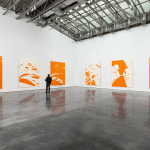
Contributed by Anne MacLeod / I first encountered the installation Antoines Organ by Rashid Johnson in 2019 by accident, as it sat serenely inside the ornate and spacious entryway of the Gropius Bau in Berlin. At the tail-end of an exhausting work trip, I was taken aback by the compelling sensory complexity of a single piece. Projecting both force and serenity, the beams of glowing grow-lights and overlapping textures of sound pulled me in. As I grew closer to the structure, subtle scents of live foliage invoked feelings of warmth and familiarity. And though I was essentially alone in the giant room, the piece itself felt like a companion.
Hidden secrets rewarded unhurried study of this work, pensive as well as dynamic, which incorporates American cultural phenomena sourced in the African diaspora. A ponytail palm tree in a hand-built orange and blue ceramic pot sat atop a Cobra CB Radio as wires connecting to the lights, speakers, and small outdated television sets crossed one another. An upright piano was concealed behind rows and columns of potted plants in various states of health and decay. Books like Richard Wrights Native Son and Paul Beattys The Sellout ornamented the grid of greenery.
Having been struck by the piece, I was excited to learn that it would be re-installed as part of the New Museums Grief and Grievance exhibition, which opened in February 2021. Conceived by curator Okwui Enwezor in 2018, the show addresses, in his words, the collective mourning of Black people living in America, the national emergency of black grief, and the normalization of white nationalism. Unfortunately, he passed away in 2019 and was unable to see his work in the exhibition.
When I saw Antoines Organ again in New York, of course, there was no spontaneous encounter, no serendipitous moment, to be had. The visit was pre-planned, with time-slots arranged ahead of time and health-waivers signed days before setting foot in the museum. The world had bent and shifted since 2019, with the murder of George Floyd, the national and international rise of the Black Lives Matter movement, and the existential stress of the global pandemic.
My friend and I rode alone, in an elevator built for 20, to the top floor: an empty room with a panoramic view of the city. We looked across the sun-soaked room over Manhattan. Then we began the descent. One story below, Antoines Organ filled the room. In Berlin, an immense space had held this piece. At the New Museum, in contrast, there was no way to see it from far away, which underlined its physical presence and magnitude. The tableau seemed to envelop or perhaps absorb the space with its geometric assertiveness, plant life, and emanating sounds. With the bright white lights in my eyes and my neck craning to see all the way to the top, I felt as though I was under its spell, that I was its subject. Yet as monumental as the piece is, it remains visually digestible in small bites, as it were: at once orderly and chaotic, geometric and organic, bountifully huge and manageably compartmentalized.
As viewers around me approached the piece, they alternately stepped back to take it in, walked closer to observe an alluring detail, and took a few steps back when their eyes wandered somewhere else. Johnsons calculated repetition forces viewers to look closer and find variation within cells that while uniform in shape and size hold their own unique stories. These stories the life of the plants, the narratives in the books, the capabilities of the technological gadgets expand and interact with the cells above, below, and to the sides, in constant communication.
Antoines Organ invited me, a white viewer, to investigate my own involvement in the systemic racism that it and the show overall probes not just as a critic of the work, but as a participant in the system it seeks to disrupt. And, with more than a little irony, the installation reminded me of the extent of my privilege: I could stand in an elite institution during a pandemic, afforded the space to appreciate a work that many of those whose circumstances the show illuminates could not. Its worth seeing more than once.
Grief and Grievance: Art and Mourning in America, conceived by Okwui Enwezor, New Museum, 235 Bowery, New York, NY. Through June 21, 2021.
About the author: Anne MacLeod is a designer, writer, and visual storyteller based in Brooklyn, NY. Her work spans fashion design and styling, branding, photography and graphic design. This is her first contribution to Two Coats of Paint.
Related posts:
Cheat sheet: Summer group shows (and what curators are writing about them)
The strategic now























Pingback: Inspiration Post 3 | Abigail's Blog